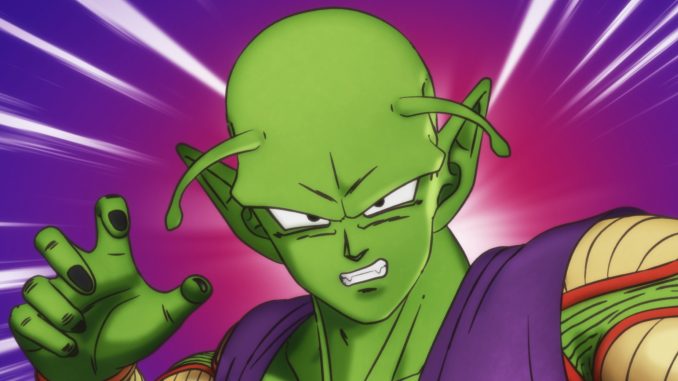Piccolo Finally Gets His Day in the Sun in Underwhelming but Fun Dragon Ball Super: Super Hero

Liking the Dragon Ball franchise can be encapsulated by watching your favorite character change over time. As a kid, maybe you liked the too-cool Trunks, the boy-bandish time-traveler who appears from nowhere to hack apart the latest villain like he was nothing. Maybe you liked Krillin, the underdog monk trying to keep up with the non-humans he’s found himself running with. But for me, Piccolo has been a favorite as I’ve aged out of Dragon Ball’s target demographic. The bone-dry Namekian doesn’t just have a cool villain-to-hero origin or the capacity for Black viewers (like Jordan Calhoun, whose memoir notes the character’s codedness in its title) to read the alien as compelling representation, he also stands as a bastion of seriousness and responsibility in a world where the child-brained Goku runs the show. He’s thrust into babysitting duties for Goku’s offspring, becoming far more of a father figure than that goofball could ever be. He’s fed up, enjoyably so, yet always comes back for more. Just like me, watching Dragon Ball Super: Super Hero, a movie that finally gives Piccolo his day in the sun.
As Dragon Ball Super: Super Hero (redundantly named because series creator/screenwriter Akira Toriyama forgot the main title when coming up with the subtitle) makes Piccolo (Christopher Sabat) its protagonist, it also consigns itself to themes of cascading legacies. This affects its heroes, villains and us, reflecting its source material’s specifics—the generations of death-defying fighters descending from Bardock to Goku to Gohan to Pan—and serialized form. If you’re unfamiliar, think of it this way: Rarely do you go too long without Batman fighting an escaped Arkham resident. Sometimes Robin takes up the mantle, figuratively or literally. Super Hero follows (super)suit.
Here, the blasts from the past are the high-tech, Nazi-like Red Ribbon Army. Updated for 2022 and the alt-right’s links to business-friendly conservatism, the organization hides behind a pharmaceutical company and adopts a mobster aesthetic of shoulder-padded suits, chomped cigars, tiny mustaches and massive pompadours. One of the more amusing twists of Super Hero is an early retelling of the Dragon Ball Z Cell Saga from the antagonists’ perspective—a story of aliens and opportunists combining their strength to take out humanity’s greatest creation…even if said creation was a power-mad bio-android.
Neo-Red Ribbon kingpin Magenta (Charles Martinet) convinces Dr. Hedo (Zach Aguilar) to help him rebuild the Army. Magenta is the son of the late Commander Red; Hedo is the superhero-loving grandson of Cell creator Dr. Gero. Hedo’s caped android creations, Gammas 1 and 2, reflect his fanboy immaturities and ironic willingness to buy into the very thing his fake heroes would hate. In a world of Punisher-loving cops, devoted MCU sycophants and doxing DC fans, this framing is a searing little ki blast. Even more relatable, Piccolo spends most of his time trying to convince everyone else around him of the threat’s seriousness.
Super Hero is familiarity on top of familiarity, but with slight tweaks in perspective and style. The most immediately noticeable difference is the morphing of its 2D characters into CG-rounded 3D models more reminiscent of cutscenes from Dragon Ball FighterZ than the anime. Shaded more broadly and moving with a weightier step, they stand out as if the environments have rejected them as foreign objects. Director Tetsuro Kodama first made use of this style in 2018’s Dragon Ball Super: Broly, in which he helmed a few CG sequences that supplemented its more traditional animation. That film’s ambitiously wild blend enhanced its title character’s over-the-top berserker style; Super Hero fully adopts the 3D look to lesser effect. It allows for camera-swirling combat—punctuated in one memorable fight with splashy comic sound-effect balloons—-but it’s underutilized and distracting as the detailed character movements seem disconnected from each other and the world around them. If those models form the basis for a new asset library at the Dragon Ball crew’s disposal, I bet they’ll eventually allow for some much-needed visual innovation. Not so much here, in what feels like a trial run.
But for this greater act of fan disservice (as many will see it), Super Hero offers equal acts of fan service: Appearances by the god of destruction Beerus and the big bad from the last movie, Broly; the gathering of the Dragon Balls and the summoning of Shenron; a Goku-Vegeta sparring match; the corny, juvenile humor that keeps Toriyama’s mega-macho fighters humble; and fights, fights, fights. Much of it is thrown away for gags, speaking directly to a fanbase that’s seen it all so many times over the course of multiple shows and 21 movies that none of it holds much narrative power.
-

-

-

-

-

-

-

-

-

-

-

-

-

-

-

-

-

-

-

-

-

-

-

-

-

-

-

-

-

-

-

-

-

-

-

-

-

-

-

-








































